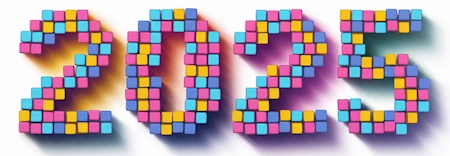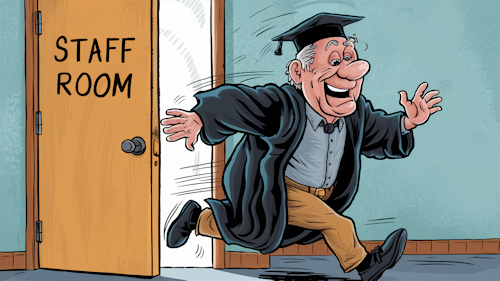Sign In | Starter Of The Day | Tablesmaster | Fun Maths | Maths Map | Topics | More
This is the Transum Newsletter for the month of January 2025.

Happy New Year - It's great to be alive
Now we have started twenty, twenty-five
A number that's special, a number that's fine
It's the sum of the cubes from one to nine*.
And to begin the year, here is the puzzle of the month.
It’s the end of the morning break at Addwell School, and ten classrooms, packed with enthusiastic students, are waiting for their next lesson to begin.
Ten teachers leave the staffroom one by one after consuming their morning coffee. The first to leave is Professor Hamnee Shah, who can’t remember which class he is timetabled to teach, so he chooses a class at random and begins teaching them.
The second teacher does the following: goes to their timetabled classroom. If there is no teacher inside, they teach their scheduled class. Otherwise, they choose a random class with no teacher and begin teaching. Every one of the remaining eight teachers does the same. What is the probability that the last teacher out of the staffroom (Ms Lattelike) teaches their timetabled class?

If you get an answer, I'd love to hear how you solved the puzzle (or your students solved it). Drop me an email at: gro.musnarT@rettelsweN
As I mentioned this time last year, I am the honorary Chair of British Scouting Overseas, Rest of the World District. Each year I set a Christmas Challenge. I guess you have a few days of the festive holiday left, so I wonder if you can do the Camp Bosrow Challenge?
And now for something completely different. Sorting Shapes exists to fill a gap in the Functional Skills offerings. There are four levels involving both two-dimensional and three-dimensional shapes. The challenge is enhanced with the fact that no mistakes are tolerated (that sounds a bit harsh). If a mistake is made you'll need to start that level again. Hopefully it will keep pupils focused and add to the sense of achievement when the level is completed.
During December, I returned to the UK to see my 92-year-old mother and the rest of the family. Mum enjoys watching the TV programme The 1% Club, so I watched a number of episodes with her while I was at her house.

Many of the questions are very similar to Transum starters and puzzles, and I’d like to think that the show’s researchers may have stumbled upon Transum while searching for question ideas. All of the questions used have been tested on members of the general public prior to the show, and are classified according to the percentage of participants who answered correctly.
Here is the big finale question from the last programme I watched. It’s the question that only 1% of the public got right:
In a room of 100 people, 99% are left-handed. How many left-handed people have to leave the room to bring that percentage down to 98%?
So if the Puzzle of the Month didn’t catch your interest, you may wish to give this conundrum some thought. Pause your reading and ponder!
These GCSE Question Collections were originally designed to be printed on paper, with each question automatically printed on a separate page. Now, I print to PDF and import it into BitPaper. Save the planet while revising!
Talking of exams, I heard that the Suneung, South Korea's gruelling university entrance exam, is an eight-hour marathon held on a single day, making it one of the toughest exams in the world. Unlike the UK, where exams are spread over weeks, Korean students face back-to-back tests with minimal breaks. The exam's significance is so immense that the entire country comes to a standstill; stock markets adjust their opening hours, and flights are grounded to ensure students can focus. This life-defining exam determines university admission, career prospects, and even relationships, reflecting the intense societal pressure around it. I found out about the Suneung from a BBC podcast called What in the World; heartily recommended.
Don't forget you can listen to this month's podcast, which is the audio version of this newsletter. You can find it on your favourite podcast catcher. It's called Transum Mathematics Puzzles.
Finally, the answer to last month's puzzle which was:
While Santa was busy delivering presents in Tran Towers, Prancer, one of his reindeer, went for a stroll to the base of Krimble Hill. Prancer then walked up the hill to see the view of Twinkle Town from the top. After enjoying the view, Prancer retraced his steps back to the Towers. His round trip took six hours. Prancer walked at an average of 4 km/h on level ground, 3 km/h uphill, and 6 km/h downhill. How far (in km) did Prancer walk?
The answer is 24km. This problem was adapted from a question in the 1991 UKMT Senior Mathematical Challenge.
The first five people to send in a correct solution were Kevin, Mala, Dalia, Tzvetanka and Beth. I have enjoyed receiving the emails from all those who took part. It is fascinating to see the wide variety of methods employed to solve the same puzzle and some examples can be found below.
That's all for now,
John
P.S. Why is a dog with a bad foot like adding 6 and 7?
A. Because he puts down three and carries the one.
* 2025 is also the square of the sum of the numbers one to nine.
Do you have any comments? It is always useful to receive feedback on this newsletter and the resources on this website so that they can be made even more useful for those learning Mathematics anywhere in the world. Click here to enter your comments.
Did you know you can follow this newsletter on Substack completely free of charge? Please note this is separate from a paid subscription to the Transum website, which unlocks a much wider range of premium resources.
Kevin, Australia
Sunday, December 1, 2024
"Let a be the time walking uphill then a/2 is the time walking downhill.
Let b be the time walking on the level.
So a +0.5a + b = 6 and 1,5a = 6 – b
Tot dist = 3a + 6a/2 + 4b = 6a + 4b = 4(6 – b) + 4b = 24km "
Tzvetanka,
Monday, December 2, 2024
"My daughter (Y5) sometimes uses a trial and error approach to solve such problems. A random (easy) trial and error process is to use 1hr each way on level ground, 2hrs uphill and 1hr downhill. It then becomes obvious that all we need to do is increase the level ground time to 1.5hrs each way in order for the total time to be 6hrs. We then got the following for the distance:
1.5hrs x 4 km/h + 2hrs x 3km/h + 1hr x 6 km/h + 1.5x4 km/h =24 km
(Level + uphill + downhill + level)
Thank you! This was wonderful and much enjoyed! "
Beth, White Bear Lake, MN
Wednesday, December 4, 2024
"Let x = time on level ground, y = time traveling uphill, and z = time traveling downhill.
He walked for 6 hours.
x+y+z=6
He traveled the same distance uphill and downhill.
3y=6z
y=2z
x+y+z=6
x+2z+z=6
x+3z=6
x=6-3z
He walked 4 km/h on level ground, 3 km/h uphill, and 6 km/h downhill.
We want the total distance
=4x+3y+6z
=4(6-3z)+3(2z)+6z
=24-12z+6z+6z
=24
Prancer walked a total of 24 km. "
Rick, US
Saturday, December 7, 2024
"Let x represent the one-way distance on level ground and y represent the one-way distance of the hill. Then x/4 represents the time he walked on level ground, y/3 is the time to walk uphill, and y/6 is the time to walk downhill. This results in the following equation.
x/4+y/3+y/6+x/4 = 6
combining and reducing fractions (in high-school math class, I would have had to separate this into multiple steps. Arg!) yields:
x/2+y/2 = 6 or
x + y = 12
Since x and y represent one-way distances, being 12 km, round trip distance is 24 km."
Eorl, Sydney, Australia
Monday, December 9, 2024
"I had to relisten but as we are not given anything to distinguish between the flat and hill, the answer must be the same regardless.
So pretend its all flat - a simple 6h * 4km/h, reveals a total distance of 24km (or 12km there and 12km back again).
This can be confirmed by pretending its all hill - 12km up @ 3km/h takes 4h, 12km down at 6km/h takes 2h, which correctly adds to 6h. "
Rick, US
Saturday, December 28, 2024
"I have come up with an alternate solution to the December 2024 puzzle.
Reading the puzzle, there does not appear to be sufficient information to determine the flat versus incline distances. With this in mind, it might be interesting to determine the average pace for the inclined path.
From the engineering part of me:
Assume that the incline path is six km long. Then Prancer needs two hours to stroll uphill and one hour to stroll downhill, for a total of three hours to traverse 12 km, for an average pace of four km per hour.
From the mathematical part of me:
Assume that the inclined portion of the trip is x km. then it takes Prancer x/3 hours to walk uphill and x/6 hours to walk downhill. Adding these two times and reducing results int x/2 hours to stroll a distance of 2x km. 2x divided by x/2 results in 4 km per hour.
Since the average pace is 4 km per hour regardless of the terrain, simply multiplying the average pace and the number of hours (6) result in the distance travelled (24 km). "
Steve Walker, BlueSky
Monday, January 13, 2025